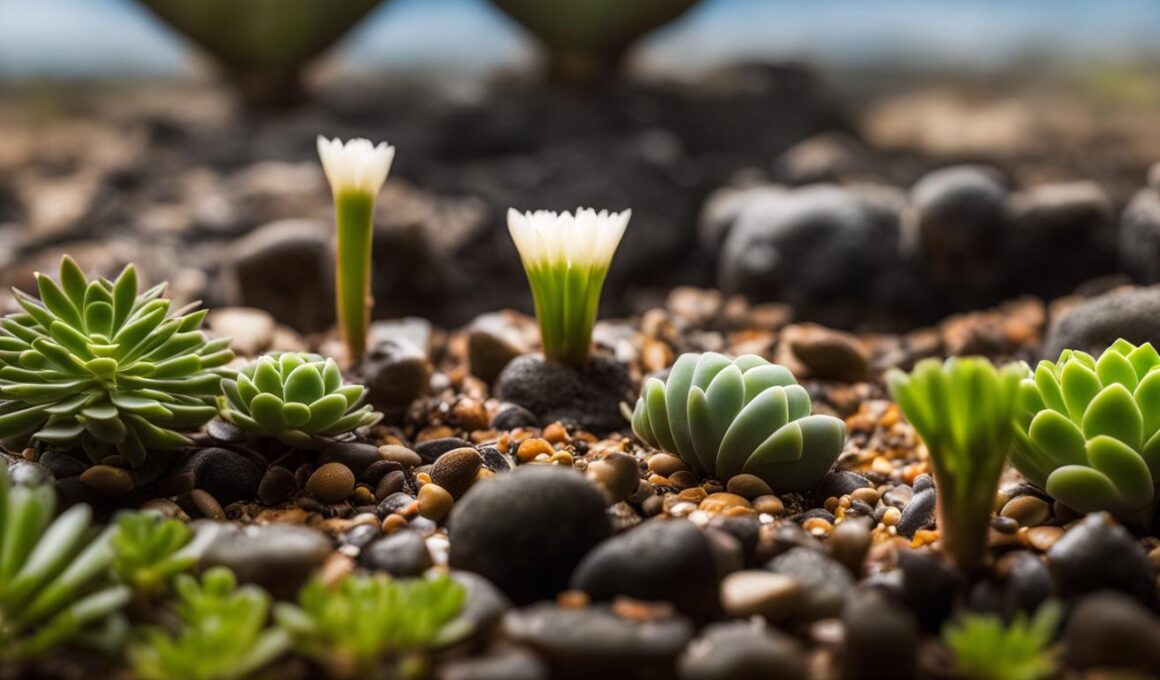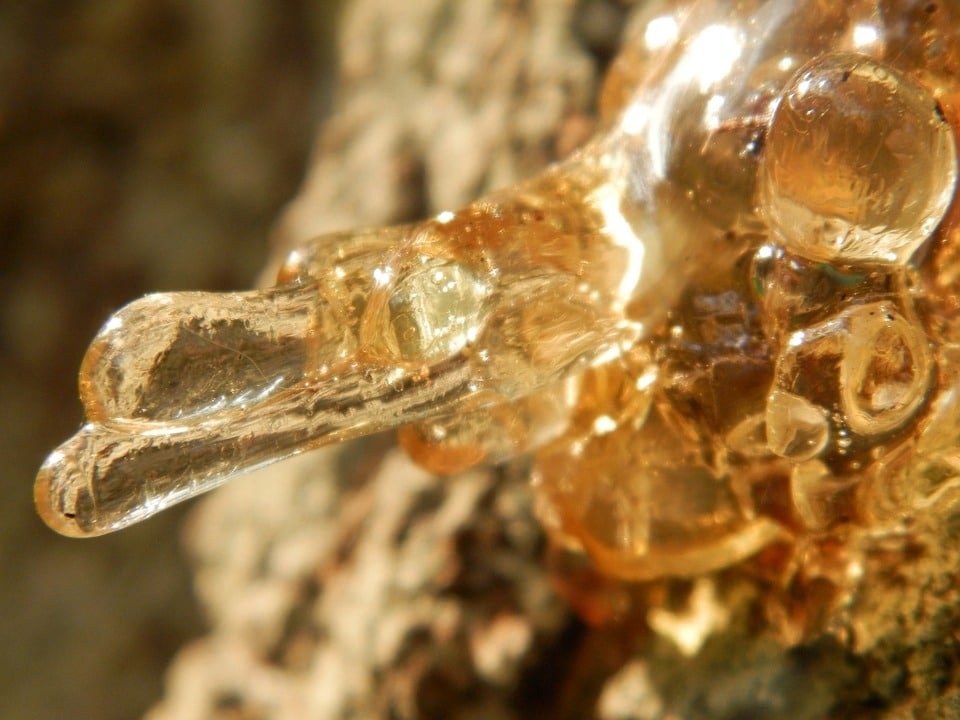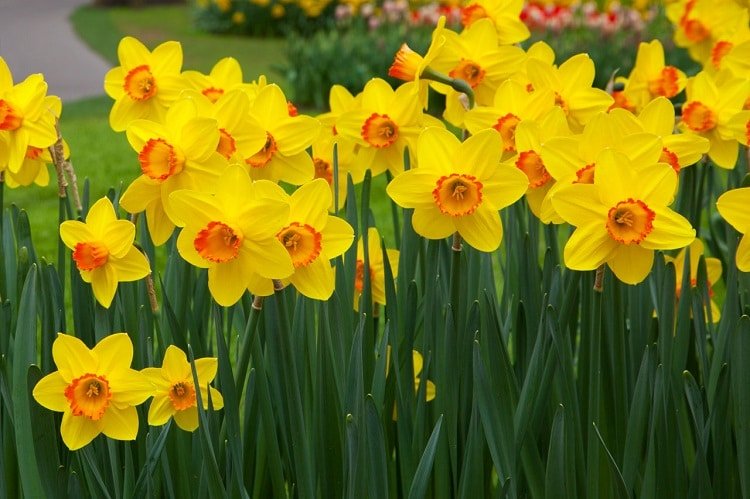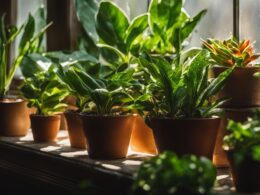If you’re a fan of growing succulents, you’re probably a proud owner of a Lithops plant, commonly known as the “living stone.” These unique and fascinating plants are native to arid regions in southern Africa. They have adapted to their environments by developing thick, succulent leaves for water storage, making them incredibly resilient and low-maintenance plants. However, this adaptation leaves many Lithops enthusiasts puzzled when they come across the plant getting soft and squishy. In this article, we will explore the factors that contribute to Lithops splitting and help you understand when this process occurs.
Post Summary
- Lithops plants, also known as “living stones,” have adapted to arid environments in southern Africa with their thick, succulent leaves for water storage.
- Despite being low-maintenance, Lithops can become soft and squishy, leading to splitting due to factors like overwatering, underwatering, and root rot.
- Understanding Lithops’ growth patterns and unique physiology is crucial for providing the proper care, including well-drained soil, minimal watering, and suitable light and temperature conditions.
- A healthy Lithops exhibits firm leaves, vibrant colors, and new growth, indicating its well-being and thriving condition.
- By following the right care tips and recognizing the signs of a healthy plant, you can prevent splitting and maintain a healthy growth environment for your Lithops.
Why Do Lithops Split?
Lithops, also known as “living stones,” can split for several reasons. One major factor is related to water absorption and growth patterns. Overwatering and underwatering can both cause Lithops to become soft and squishy. Overwatering leads to engorged cells within the leaves and vertical wrinkles, indicating the need for reduced watering. Underwatering causes the cells to lose turgor and can result in a wrinkled or shriveled appearance. Additionally, root rot, often caused by overwatering, can lead to a failure to absorb water and nutrients.
Proper care and understanding of Lithops’ water requirements are essential to prevent splitting. It is crucial to provide the right amount of water to maintain the plant’s health. This can be achieved by allowing the soil to dry completely between watering sessions. A well-draining soil mix consisting of cactus mix, potting mix, pebbles, and perlite is recommended. By using a well-draining soil, excess water can easily drain away, reducing the risk of overwatering and root rot.
In addition to water absorption, understanding Lithops’ growth patterns is crucial for preventing splitting. These plants have a unique growth cycle where they form a new pair of leaves each year while the old ones shrivel. This process typically begins after the blooming season. By recognizing and respecting this growth pattern, you can ensure that you provide the right conditions for your Lithops to thrive.
It is worth noting that factors such as temperature and light can also influence Lithops’ splitting. Extreme temperatures and sudden temperature fluctuations can stress the plant and contribute to splitting. Similarly, inadequate sunlight or exposure to direct sunlight for prolonged periods can affect their overall health. Maintaining a stable temperature and providing bright, indirect light will help create a favorable environment for your Lithops.
| Reasons for Lithops Splitting | Water Absorption | Growth Patterns |
|---|---|---|
| Overwatering | Properly watering Lithops helps prevent splitting due to engorged cells and vertical wrinkles caused by overwatering. | Understanding the growth cycle of Lithops allows you to provide the right conditions for their development. |
| Underwatering | Adequate watering prevents loss of turgor and maintains the plant’s health, preventing wrinkled or shriveled appearance. | Respecting Lithops’ growth patterns, such as the formation of new leaves and the shedding of old ones, helps prevent splitting. |
| Root Rot | Overwatering can lead to root rot, hindering the plant’s ability to absorb water and nutrients. | Understanding Lithops’ growth patterns allows you to detect any abnormalities and take appropriate action to prevent splitting. |
Understanding Lithops Physiology
Lithops, also known as “living stones,” have a unique growth pattern and reproductive process. Each year, they form a new pair of leaves while the old ones shrivel. This growth cycle begins after the blooming season. In their natural habitat in South Africa and Namibia, Lithops have adapted to survive in harsh conditions, including water scarcity and extreme temperatures.
Lithops plants have evolved to blend in with their surroundings, resembling rocks, to avoid predators. Their ability to mimic their environment is a fascinating adaptation that contributes to their survival. To thrive, Lithops require well-drained soil with a high percentage of rock or grit. This ensures that excess water is quickly drained away, preventing the risk of root rot.
In terms of sunlight, Lithops need plenty of direct sunlight to support their growth. They thrive in bright, indirect light and can tolerate high temperatures. However, they also require protection from temperature fluctuations, as sudden changes in temperature can be detrimental to their health.
To summarize, understanding the growth patterns and natural habitat of Lithops is key to providing them with the optimal conditions for their care. By replicating their natural environment and providing the right soil mix, sunlight, and temperature, you can ensure that your Lithops thrive and continue to be a remarkable addition to your succulent collection.
Growth Patterns
Lithops have a unique growth pattern characterized by the formation of a new pair of leaves each year. As the old leaves shrivel, new leaves emerge between them, contributing to the plant’s distinct appearance. This growth cycle is crucial for the continued development and survival of the Lithops plant.
Reproduction
Lithops reproduce through the formation of new leaves, which eventually split and reveal a new pair of leaves within. This process ensures the perpetuation of the species. Understanding the reproductive process of Lithops can help in providing the necessary care and support for their growth and propagation.
Natural Habitat
Lithops are native to arid regions in southern Africa, such as South Africa and Namibia. In these habitats, they have adapted to survive in extreme conditions, such as water scarcity and high temperatures. Their ability to blend in with their surroundings and their preference for well-drained soil and direct sunlight are all characteristics that have allowed them to thrive in their natural habitat.
Signs of a Healthy Lithops
Ensuring that your Lithops plant remains healthy is vital for its growth and longevity. By recognizing the signs of a healthy Lithops, you can provide the appropriate care and create an optimal environment for its well-being. Here are the key characteristics to look out for:
Firm Leaves
A healthy Lithops plant exhibits firm and plump leaves. When gently pressed, the leaves should not feel soft or mushy. Instead, they should have a turgid texture, indicating that the plant is well-hydrated and storing enough water. Firm leaves are a good indicator of the overall health of your Lithops.
Vibrant Colors
The vibrant colors of a Lithops are a reflection of its well-being. Healthy Lithops plants display rich hues and patterns that blend seamlessly with their surroundings. The colors can range from various shades of green to red, brown, yellow, and even purple. The intensity and vibrancy of the colors indicate that the plant is receiving adequate light and nutrients.
New Growth
Observing new growth in your Lithops is a positive indicator that the plant is thriving. As Lithops follow their unique growth pattern, new leaves emerge between the existing pair. The presence of new growth suggests that the plant has successfully completed its growth cycle and is ready for the next stage of development.
By paying attention to these signs, you can ensure that your Lithops plant is healthy and thriving. Remember to provide the appropriate care, including minimal watering, well-draining soil, and adequate sunlight. With proper care, your Lithops will continue to be a fascinating addition to your succulent collection.
Conclusion
In conclusion, preventing Lithops splitting and maintaining a healthy growth environment for these unique and fascinating plants requires proper care and attention. By understanding the factors that contribute to splitting, such as overwatering, underwatering, and root rot, you can take the necessary steps to avoid these issues.
To prevent splitting, it is crucial to follow the recommended watering requirements. Allow the soil to dry completely between watering sessions, ensuring that you do not overwater or underwater your Lithops. Using a well-draining soil mix that includes a blend of cactus mix, potting mix, pebbles, and perlite is essential for proper water absorption and root health.
Furthermore, providing the right amount of light and maintaining stable temperatures are key to the healthy growth of Lithops. These plants thrive in bright, indirect light and average household temperatures. Avoid exposing them to extreme temperature fluctuations, as this can negatively impact their growth and overall health.
By taking these measures and closely monitoring the signs of a healthy Lithops, such as firm leaves, vibrant colors, and new growth, you can ensure that your plant remains in optimal condition. Remember, creating a suitable growth environment is essential for the resilience and longevity of your Lithops plant.
FAQ
Why does my Lithops plant split?
Lithops can split due to factors such as overwatering, underwatering, and root rot. Understanding proper care methods and providing the right environment can help prevent splitting.
How does water absorption and growth patterns affect Lithops splitting?
Overwatering and underwatering can both cause Lithops to become soft and squishy. Overwatering leads to engorged cells, while underwatering causes a loss of turgor. Root rot, often caused by overwatering, can hinder water absorption.
What is the natural habitat and reproductive process of Lithops?
Lithops are native to arid regions in southern Africa and have adapted to survive in harsh conditions with water scarcity and extreme temperatures. They have a unique growth pattern and reproductive process, forming new leaves each year while the old ones shrivel.
How do I care for Lithops?
Lithops require minimal watering, well-draining soil, plenty of sunlight, and protection from temperature fluctuations. Using a well-draining soil mix, allowing the soil to dry completely between watering sessions, and providing bright, indirect light are crucial for their health.
What are the signs of a healthy Lithops plant?
A healthy Lithops plant will have firm, plump leaves and vibrant colors that blend with their surroundings. There should be no signs of overwatering or underwatering, shriveled leaves, or horizontal wrinkles.
How can I prevent Lithops splitting and maintain a healthy growth environment?
By understanding proper care methods and recognizing the signs of a healthy plant, you can ensure that your Lithops thrives. This includes providing the right amount of water, using a well-draining soil mix, and protecting them from temperature fluctuations.
Can the Growth Cycle of Lithops Affect When They Split?
The lithops growth cycle guide plays a crucial role in determining when these unique plants split. The growth cycle, which includes periods of growth, rest, and splitting, is influenced by factors like light, water, and temperature. Understanding the growth cycle is essential for successful lithops care and propagation.










